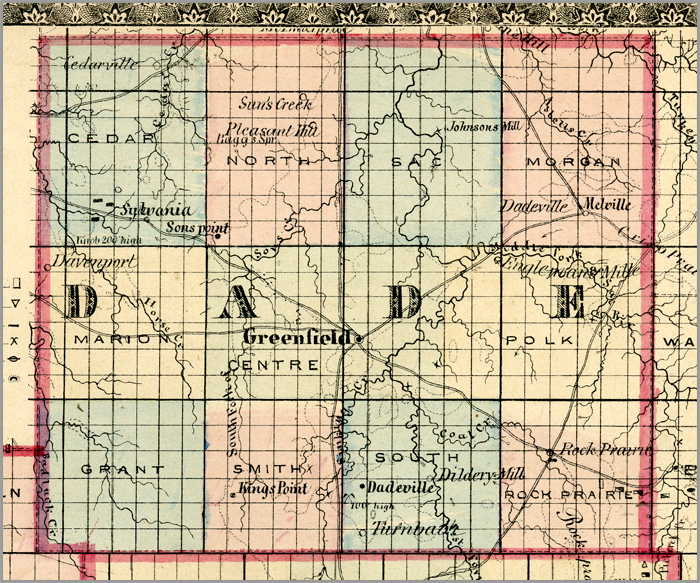Dade County, Missouri

- Formed: January 29, 1841
- County Population 1860: 6,727
- Slave Population 1860: 350
- Civil War Engagements
– Burning of county courthouse, November
1863
Image courtesy of Wilson’s Creek National Battlefield
The first settler of Dade County, Missouri was John Crisp in the early 1820s. Many other settlers soon followed, most coming from Tennessee, Kentucky, or the Carolinas. The county was officially formed out of what are now Barry and Greene Counties in 1841, and Greenfield was named the county seat. The county was named after Francis Langhorne Dade, who was a Major in the Second Seminole War of 1835.
Nathaniel Boone, Daniel Boone’s son, moved to Dade County in 1837 and lived near present day Ash Grove until his death in 1856. Boone and his family members were prominent citizens of the county, and were responsible for forming the Boone’s Salt Lick Manufacture. Many of his slaves and family members remained in the area after his death. In 1850 the Dade County population reached over 4,000. This influx in population was due to the discovery of a coal belt in the northwest part of the county, which led to not only increased settlement, but also business and industry in Dade County.
Dade County has many natural sources of fresh water and timber, including oak and hickory. The soil is very fertile and good for growing corn, wheat, and tobacco, as well as apples, peaches, pears, plums, and grapes. The area also has natural coal, lead, and zinc deposits. All of these natural qualities were appealing to incoming settlers looking for prosperous area to make their home. Dade County originally belonged to the Osage, but was ceded to the United States. Dade County was officially established on January 29, 1841 with the county seat being located in Greenfield.
During the Mexican War, soldiers from the area fought under local Colonel James J. Clarkson, who would later fight in local Civil War regiments. When the Civil War began, the majority of the county supported slavery, even though the actual slave population in the county was small in 1860, only 350 individuals. However, only the Southern half of the county fought predominately for the Confederacy. A local man, John Trousdale Coffee, became a prominent Confederate colonel. The Northern half, though pro-slavery, was anti-secessionist and fought for the Union. From 1861-1864, many military regiments formed in Dade County. These included: Companies A and D, 6th Missouri Cavalry in 1861, the Union Militia Company in 1862, and Company I, 18th Missouri Cavalry in 1863.
Though there were no major battles fought within the Dade County borders, the people did not escape the war. The county was host to many different occupations from both sides of the battle throughout the war. In October of 1863, General Joe Shelby and his Confederate troops entered Greenfield and burned the county courthouse, though they did move the county’s court records before setting fire to the building. The county slowly tried to rebuild itself after the war was over. The population in 1870 was 8,863, up just over 1,000 from ten years before. The first public school opened in 1872, and the town of Billings formed in 1881. The same year a German settlement developed that served to increase the diversity of county.
 Browse all collections in Dade County
Browse all collections in Dade County
- Consulted:
- A.J. Young, History of Dade County and Her People, Vol. 1 (Pioneer History Company, 1917).
- History of Hickory, Polk, Cedar, Dade, and Barton Counties, Missouri, From the Earliest Time to the Present, (Greenville, SC: Southern Historical Press, Inc. 2002).
- Dade County, MO, 1860 U.S. Federal Census – Slave Schedules [database on-line]. Provo, UT, USA: Ancestry.com Operations Inc, 2004. Original data: United States of America, Bureau of the Census. Eighth Census of the United States, 1860. Washington, D.C.: National Archives and Records Administration, 1860. M653, 1,438 rolls












